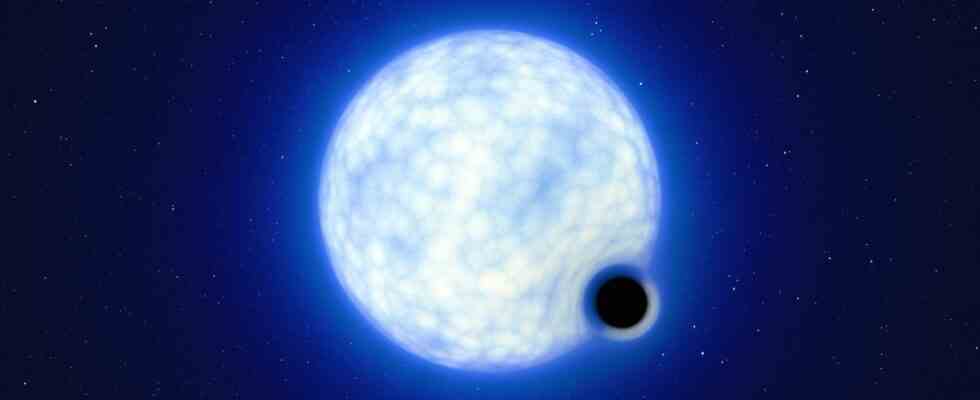In the Large Magellanic Cloud
:
Researchers have spotted ‘quiet’ black hole beyond the Milky Way
This artist’s rendering shows what the VFTS 243 binary might look like if we observed it up close. Located in the Tarantula Nebula in the Large Magellanic Cloud, the system consists of a hot, blue star and a black hole.
Photo: dpa/-
lions Surprise for the astronomers: They discover a special black hole outside the Milky Way. It amazes the researchers for two different reasons.
Astronomers have found a strange black hole in a galaxy neighboring the Milky Way. The special thing about it: The black hole in the Large Magellanic Cloud is “quiet” – it does not reveal itself through radiation, but only through its gravitational pull. According to the researchers, it would be the first discovery of a quiet black hole outside the Milky Way. In addition, this stellar black hole was apparently created by a “direct collapse”, i.e. without an accompanying supernova explosion, according to the scientists in the journal “Nature Astronomy”.
“Stellar black holes are the remnants of large stars originally more than 15 times the mass of our Sun,” explains team leader Tomer Shenar from the University of Louvain in Belgium. When such a star has exhausted its nuclear energy supply, it collapses under its own gravitational pull into a black hole. This catastrophe is usually accompanied by a supernova explosion, in which some of the stellar matter is ejected into space.
Astronomers suspect that there are billions of such stellar black holes in the Milky Way and surrounding neighboring galaxies, the “Local Group”. However, only a few are actually known – namely those that form a double system with another star. The black holes then often suck off matter from their partner star with their strong gravitational pull. Before this gas falls into the black hole, it heats up and then emits radiation in the high-energy X-ray range – thus revealing the presence of the black hole.
In fact, there should also be many quiescent black holes that are not hit by matter. Shenar and his colleagues have targeted nearly a thousand massive stars in the region of the Tarantula Nebula in the Large Magellanic Cloud using the European Southern Observatory’s Very Large Telescope in Chile to search for such quiet black holes.
The team finally struck gold: they found a telltale periodic motion around hot blue star VFTS 243. The star, which itself contains 24 times the mass of the sun, apparently forms a close binary system with another object with at least nine solar masses. The two objects orbit each other every 10.4 days.
;)
15 Pictures Spectacular – the most beautiful pictures of the super moon
Photo: dpa/Meng Dingbo
The second object itself remains completely invisible. The researchers searched for radiation from another star in the light from VFTS 243 – without success. “It follows from the mass of the invisible object that it must be a black hole,” state Shenar and his colleagues. And this black hole is also quiet, it doesn’t emit any X-rays either. This would have made it possible for the first time to detect such a black hole outside the Milky Way – an important step in estimating how many such objects there are.
But the dark companion of VFTS 243 had another surprise in store: The orbits of the binary system are apparently almost circular. However, when a stellar black hole is formed, when the collapsing star ejects its outer envelope into space, it does not happen symmetrically. This gives the black hole a powerful push – and it puts it on a highly elliptical orbit. In extreme cases, the black hole can even be catapulted out of the binary.
The surprisingly circular orbit suggests that VFTS 243’s black hole formed without a supernova explosion. “Recently, there have been hints of such a direct collapse scenario,” explains Shenar. “But our study probably provides one of the most direct indications of this to date.”

